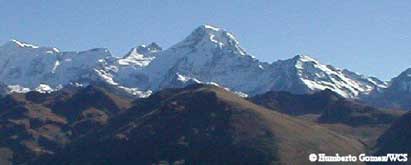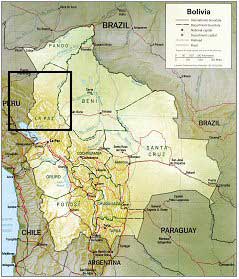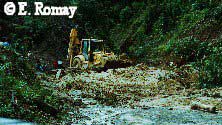 |
 |
|
» Back to Main Page » The Auction » The Winning Bid » All About Madidi » The Scientist and the Monkey » 60 Minutes Seeks The Monkey » WCS Protects Madidi Land And Species » The GoldenPalace.com Monkey » How the Monkey was Discovered » Scientists Observe Monkeys » Focus on Madidi's Diverse Wildlife  |
All About Madidi From snow-capped peaks in the Apolobamba range of the Andes to tropical lowland basins in the Amazon, the Madidi landscape encompasses an area larger than Vermont and New Hampshire combined. The landscape includes an incredible range of ecosystems, from high altitude grasslands to clouds forests, lowland tropical forests to pristine lowland savannas. Madidi is part of a vast wilderness that includes neighboring protected areas in Bolivia and southeastern Peru. Madidi is one of the most biologically diverse protected areas on the planet. The park is home to over 1,000 bird species, representing a whopping 11% of the world’s 9,000 bird species. Madidi contains large populations of Latin America’s most charismatic wildlife species: jaguar, spectacled bear, maned wolf, vicuña, giant otter, Andean condor and military macaw, among others. The newly discovered monkey species lives in Madidi and nowhere else.  Since the early 1990s, WCS has worked to protect Madidi and its wildlife from a number of threats. Our approach includes wildlife research, community outreach, training for park guards and government officials, and sustainable development initiatives. We work closely with local partners including FUNDESNAP, the Bolivian National Parks Service (SERNAP), and the Tacana indigenous group. To learn more about WCS activities at Madidi, click here.
Since the early 1990s, WCS has worked to protect Madidi and its wildlife from a number of threats. Our approach includes wildlife research, community outreach, training for park guards and government officials, and sustainable development initiatives. We work closely with local partners including FUNDESNAP, the Bolivian National Parks Service (SERNAP), and the Tacana indigenous group. To learn more about WCS activities at Madidi, click here.
The Madidi landscape covers over 50,000 sq km and extends into two protected areas into southern Peru. The wilderness includes Madidi National Park and Natural Area of Integrated Management, as well as two other Bolivian protected areas: Apolobamba Natural Area of Integrated Management and the Pilón Lajas Biosphere Reserve and Indigenous Territory.  Madidi is also culturally and historically important. The Madidi landscape is home to at least seven indigenous groups, as well as more recent mestizo and colonist arrivals. The Madidi protected area partially contains indigenous territories for the following groups: the Tacana (two separate territories), the Lecos (two territories) and the Tacana-Quechua. Moxos, in the upland cloud forests of Madidi, was the site of the first Jesuit Mission in Bolivia and the trail to it provided the Spanish Conquistadors with the first access point to the tropical lowlands of Bolivia.
Madidi is also culturally and historically important. The Madidi landscape is home to at least seven indigenous groups, as well as more recent mestizo and colonist arrivals. The Madidi protected area partially contains indigenous territories for the following groups: the Tacana (two separate territories), the Lecos (two territories) and the Tacana-Quechua. Moxos, in the upland cloud forests of Madidi, was the site of the first Jesuit Mission in Bolivia and the trail to it provided the Spanish Conquistadors with the first access point to the tropical lowlands of Bolivia.
Madidi Needs Your Help The biggest threats to the Madidi landscape are the advancement of the agricultural frontier and the construction of new roads. The expansion of agriculture into undisturbed habitat is a direct threat to wildlife because it destroys their habitat. Habitat loss also affects local communities that depend on the forests for food and other products. Likewise, proposed road developments will bisect large areas of pristine forest, cutting wildlife habitat into small fragments and providing access for activities such as agriculture and illegal hunting. Human settlements inevitably sprout up along newly created roads which results in additional habitat loss and hunting. Deforestation in Bolivia has increased over the past two decades - studies indicate that over 1000 sq. mi. (2,590 sq. km.) of forests are now lost annually in Bolivia.  To save a national treasure, the Bolivian government declared Madidi a protected area in 1995. Previously, commercial logging enterprises had severely affected wildlife populations in the park. However after almost a decade of efforts from park guards and the National Parks Service, wildlife populations are recovering. For example, a two-year investment of over US $400,000 in Madidi resulted in the eviction of 41 illegal logging camps with over 1,200 people. Soon afterward, populations of peccaries and other wildlife rebounded. Madidi's local economy is increasingly based on a blossoming ecotourism industry.
To save a national treasure, the Bolivian government declared Madidi a protected area in 1995. Previously, commercial logging enterprises had severely affected wildlife populations in the park. However after almost a decade of efforts from park guards and the National Parks Service, wildlife populations are recovering. For example, a two-year investment of over US $400,000 in Madidi resulted in the eviction of 41 illegal logging camps with over 1,200 people. Soon afterward, populations of peccaries and other wildlife rebounded. Madidi's local economy is increasingly based on a blossoming ecotourism industry.
A management plan now in place gives a clear development vision for the region based on ecotourism and the sustainable harvest of natural resources. Most importantly, the management vision recognizes that local communities are the key stakeholders in the long-term future of Madidi. In order to carry out efforts to save Madidi, the protected area requires an annual operating budget of US $550,000, equivalent to about US $30 per sq. km. per year. This could be achieved through the establishment of a US $10 million trust fund. The February auction will help build the Madidi trust fund. 100% of the winning bid to name the new monkey species (see photos) will go to FUNDESNAP's Madidi trust fund. |
 |
|
| Copyright © 2025 GoldenPalaceMonkey.com. All rights reserved. This site is in no way affiliated with WCS.org. |
|
